Innovation and New Technologies Report: SBM4301 Assignment
VerifiedAdded on 2022/08/25
|8
|2763
|22
Report
AI Summary
This report delves into the realm of technological innovation and disruptive technologies, examining their profound impact on businesses and society. It begins by highlighting the rapid pace of technological advancements and their influence on various aspects of life, emphasizing innovation as a key driver of competitive advantage. The report then explores the Internet of Things (IoT) as a prominent disruptive technology, defining its core components and showcasing its transformative effects across industries. Through real-world examples like Disney's MagicBand and Harley Davidson's manufacturing processes, the report illustrates how IoT enhances customer experiences, improves operational efficiency, and fosters new revenue streams. Furthermore, it discusses the benefits of IoT for both internal and external stakeholders, while also acknowledging potential challenges such as security concerns and regulatory complexities. The report also discusses the positive and negative impacts of technological innovation on businesses and society. It concludes by emphasizing the importance of responsible and inclusive approaches to ensure that technological advancements yield substantial social and economic benefits.
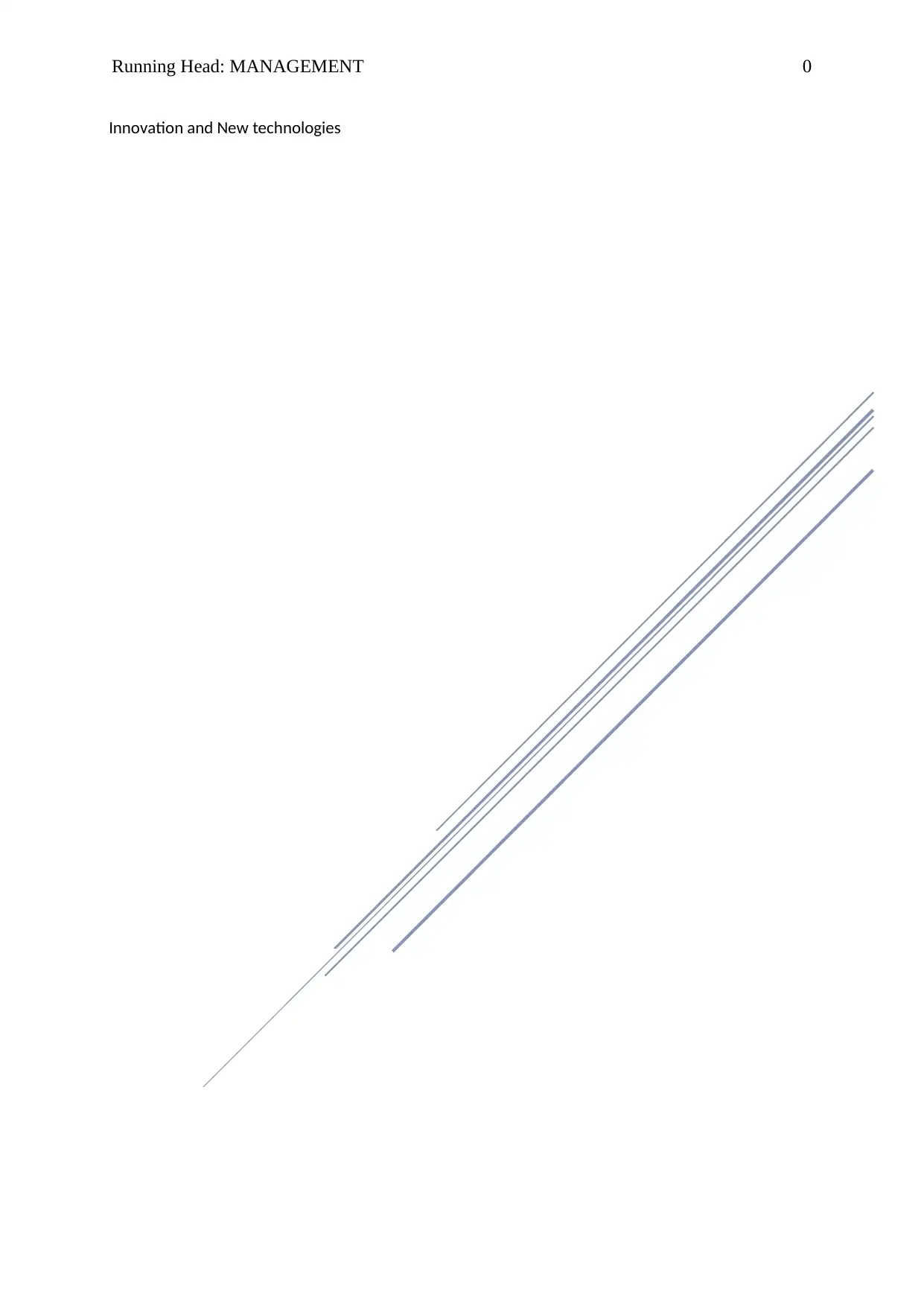
Running Head: MANAGEMENT 0
Innovation and New technologies
Innovation and New technologies
Paraphrase This Document
Need a fresh take? Get an instant paraphrase of this document with our AI Paraphraser
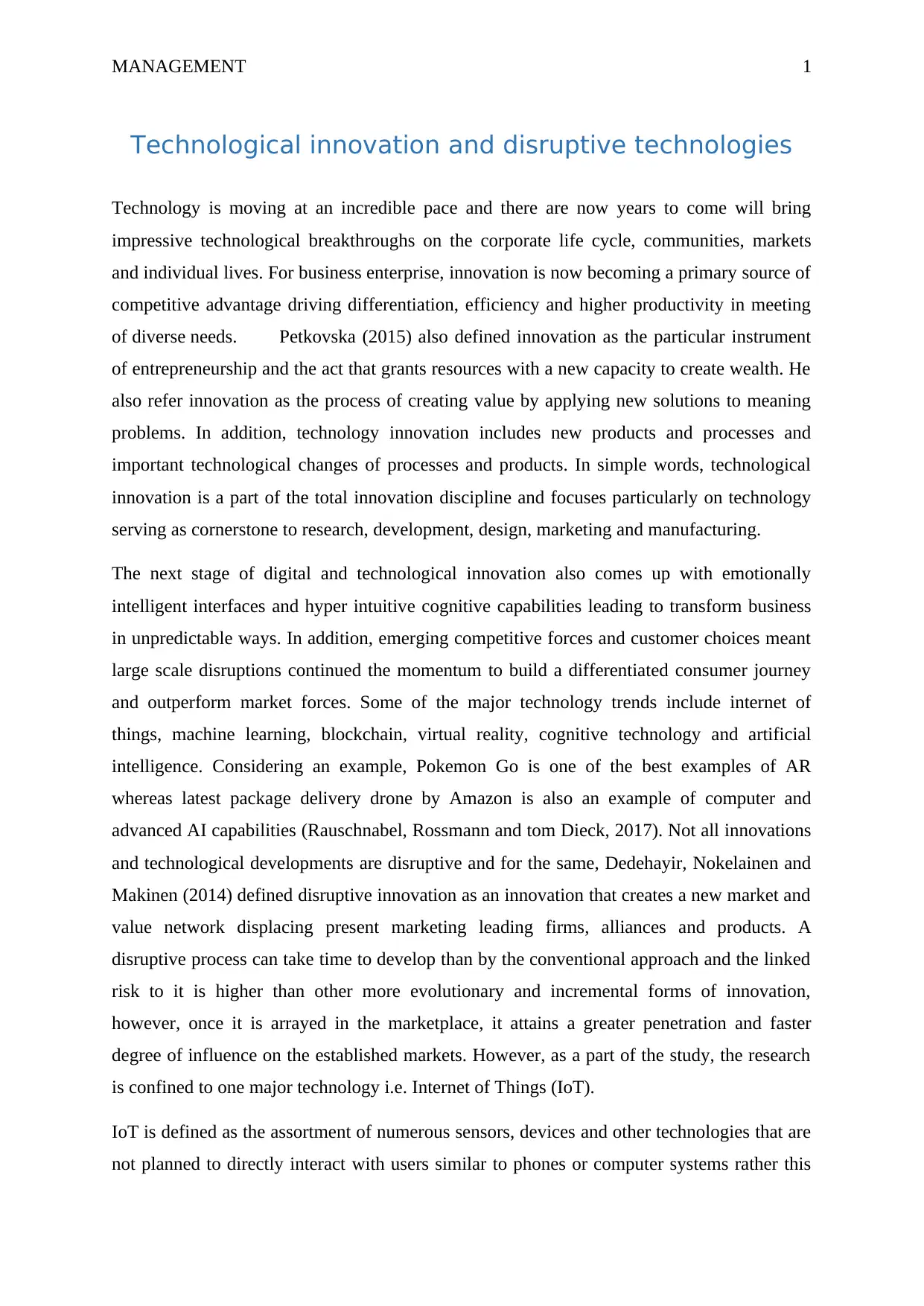
MANAGEMENT 1
Technological innovation and disruptive technologies
Technology is moving at an incredible pace and there are now years to come will bring
impressive technological breakthroughs on the corporate life cycle, communities, markets
and individual lives. For business enterprise, innovation is now becoming a primary source of
competitive advantage driving differentiation, efficiency and higher productivity in meeting
of diverse needs. Petkovska (2015) also defined innovation as the particular instrument
of entrepreneurship and the act that grants resources with a new capacity to create wealth. He
also refer innovation as the process of creating value by applying new solutions to meaning
problems. In addition, technology innovation includes new products and processes and
important technological changes of processes and products. In simple words, technological
innovation is a part of the total innovation discipline and focuses particularly on technology
serving as cornerstone to research, development, design, marketing and manufacturing.
The next stage of digital and technological innovation also comes up with emotionally
intelligent interfaces and hyper intuitive cognitive capabilities leading to transform business
in unpredictable ways. In addition, emerging competitive forces and customer choices meant
large scale disruptions continued the momentum to build a differentiated consumer journey
and outperform market forces. Some of the major technology trends include internet of
things, machine learning, blockchain, virtual reality, cognitive technology and artificial
intelligence. Considering an example, Pokemon Go is one of the best examples of AR
whereas latest package delivery drone by Amazon is also an example of computer and
advanced AI capabilities (Rauschnabel, Rossmann and tom Dieck, 2017). Not all innovations
and technological developments are disruptive and for the same, Dedehayir, Nokelainen and
Makinen (2014) defined disruptive innovation as an innovation that creates a new market and
value network displacing present marketing leading firms, alliances and products. A
disruptive process can take time to develop than by the conventional approach and the linked
risk to it is higher than other more evolutionary and incremental forms of innovation,
however, once it is arrayed in the marketplace, it attains a greater penetration and faster
degree of influence on the established markets. However, as a part of the study, the research
is confined to one major technology i.e. Internet of Things (IoT).
IoT is defined as the assortment of numerous sensors, devices and other technologies that are
not planned to directly interact with users similar to phones or computer systems rather this
Technological innovation and disruptive technologies
Technology is moving at an incredible pace and there are now years to come will bring
impressive technological breakthroughs on the corporate life cycle, communities, markets
and individual lives. For business enterprise, innovation is now becoming a primary source of
competitive advantage driving differentiation, efficiency and higher productivity in meeting
of diverse needs. Petkovska (2015) also defined innovation as the particular instrument
of entrepreneurship and the act that grants resources with a new capacity to create wealth. He
also refer innovation as the process of creating value by applying new solutions to meaning
problems. In addition, technology innovation includes new products and processes and
important technological changes of processes and products. In simple words, technological
innovation is a part of the total innovation discipline and focuses particularly on technology
serving as cornerstone to research, development, design, marketing and manufacturing.
The next stage of digital and technological innovation also comes up with emotionally
intelligent interfaces and hyper intuitive cognitive capabilities leading to transform business
in unpredictable ways. In addition, emerging competitive forces and customer choices meant
large scale disruptions continued the momentum to build a differentiated consumer journey
and outperform market forces. Some of the major technology trends include internet of
things, machine learning, blockchain, virtual reality, cognitive technology and artificial
intelligence. Considering an example, Pokemon Go is one of the best examples of AR
whereas latest package delivery drone by Amazon is also an example of computer and
advanced AI capabilities (Rauschnabel, Rossmann and tom Dieck, 2017). Not all innovations
and technological developments are disruptive and for the same, Dedehayir, Nokelainen and
Makinen (2014) defined disruptive innovation as an innovation that creates a new market and
value network displacing present marketing leading firms, alliances and products. A
disruptive process can take time to develop than by the conventional approach and the linked
risk to it is higher than other more evolutionary and incremental forms of innovation,
however, once it is arrayed in the marketplace, it attains a greater penetration and faster
degree of influence on the established markets. However, as a part of the study, the research
is confined to one major technology i.e. Internet of Things (IoT).
IoT is defined as the assortment of numerous sensors, devices and other technologies that are
not planned to directly interact with users similar to phones or computer systems rather this
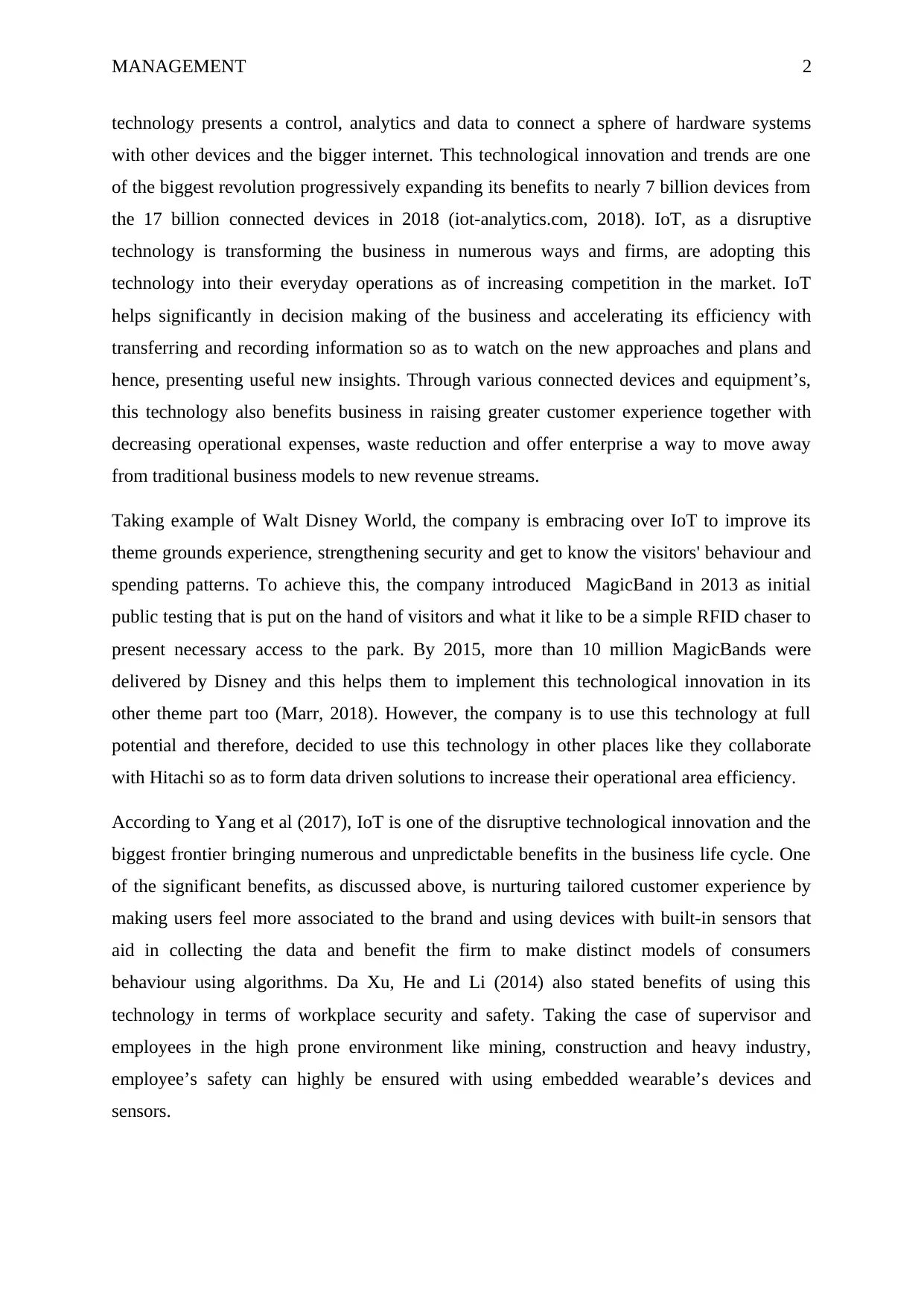
MANAGEMENT 2
technology presents a control, analytics and data to connect a sphere of hardware systems
with other devices and the bigger internet. This technological innovation and trends are one
of the biggest revolution progressively expanding its benefits to nearly 7 billion devices from
the 17 billion connected devices in 2018 (iot-analytics.com, 2018). IoT, as a disruptive
technology is transforming the business in numerous ways and firms, are adopting this
technology into their everyday operations as of increasing competition in the market. IoT
helps significantly in decision making of the business and accelerating its efficiency with
transferring and recording information so as to watch on the new approaches and plans and
hence, presenting useful new insights. Through various connected devices and equipment’s,
this technology also benefits business in raising greater customer experience together with
decreasing operational expenses, waste reduction and offer enterprise a way to move away
from traditional business models to new revenue streams.
Taking example of Walt Disney World, the company is embracing over IoT to improve its
theme grounds experience, strengthening security and get to know the visitors' behaviour and
spending patterns. To achieve this, the company introduced MagicBand in 2013 as initial
public testing that is put on the hand of visitors and what it like to be a simple RFID chaser to
present necessary access to the park. By 2015, more than 10 million MagicBands were
delivered by Disney and this helps them to implement this technological innovation in its
other theme part too (Marr, 2018). However, the company is to use this technology at full
potential and therefore, decided to use this technology in other places like they collaborate
with Hitachi so as to form data driven solutions to increase their operational area efficiency.
According to Yang et al (2017), IoT is one of the disruptive technological innovation and the
biggest frontier bringing numerous and unpredictable benefits in the business life cycle. One
of the significant benefits, as discussed above, is nurturing tailored customer experience by
making users feel more associated to the brand and using devices with built-in sensors that
aid in collecting the data and benefit the firm to make distinct models of consumers
behaviour using algorithms. Da Xu, He and Li (2014) also stated benefits of using this
technology in terms of workplace security and safety. Taking the case of supervisor and
employees in the high prone environment like mining, construction and heavy industry,
employee’s safety can highly be ensured with using embedded wearable’s devices and
sensors.
technology presents a control, analytics and data to connect a sphere of hardware systems
with other devices and the bigger internet. This technological innovation and trends are one
of the biggest revolution progressively expanding its benefits to nearly 7 billion devices from
the 17 billion connected devices in 2018 (iot-analytics.com, 2018). IoT, as a disruptive
technology is transforming the business in numerous ways and firms, are adopting this
technology into their everyday operations as of increasing competition in the market. IoT
helps significantly in decision making of the business and accelerating its efficiency with
transferring and recording information so as to watch on the new approaches and plans and
hence, presenting useful new insights. Through various connected devices and equipment’s,
this technology also benefits business in raising greater customer experience together with
decreasing operational expenses, waste reduction and offer enterprise a way to move away
from traditional business models to new revenue streams.
Taking example of Walt Disney World, the company is embracing over IoT to improve its
theme grounds experience, strengthening security and get to know the visitors' behaviour and
spending patterns. To achieve this, the company introduced MagicBand in 2013 as initial
public testing that is put on the hand of visitors and what it like to be a simple RFID chaser to
present necessary access to the park. By 2015, more than 10 million MagicBands were
delivered by Disney and this helps them to implement this technological innovation in its
other theme part too (Marr, 2018). However, the company is to use this technology at full
potential and therefore, decided to use this technology in other places like they collaborate
with Hitachi so as to form data driven solutions to increase their operational area efficiency.
According to Yang et al (2017), IoT is one of the disruptive technological innovation and the
biggest frontier bringing numerous and unpredictable benefits in the business life cycle. One
of the significant benefits, as discussed above, is nurturing tailored customer experience by
making users feel more associated to the brand and using devices with built-in sensors that
aid in collecting the data and benefit the firm to make distinct models of consumers
behaviour using algorithms. Da Xu, He and Li (2014) also stated benefits of using this
technology in terms of workplace security and safety. Taking the case of supervisor and
employees in the high prone environment like mining, construction and heavy industry,
employee’s safety can highly be ensured with using embedded wearable’s devices and
sensors.
⊘ This is a preview!⊘
Do you want full access?
Subscribe today to unlock all pages.

Trusted by 1+ million students worldwide
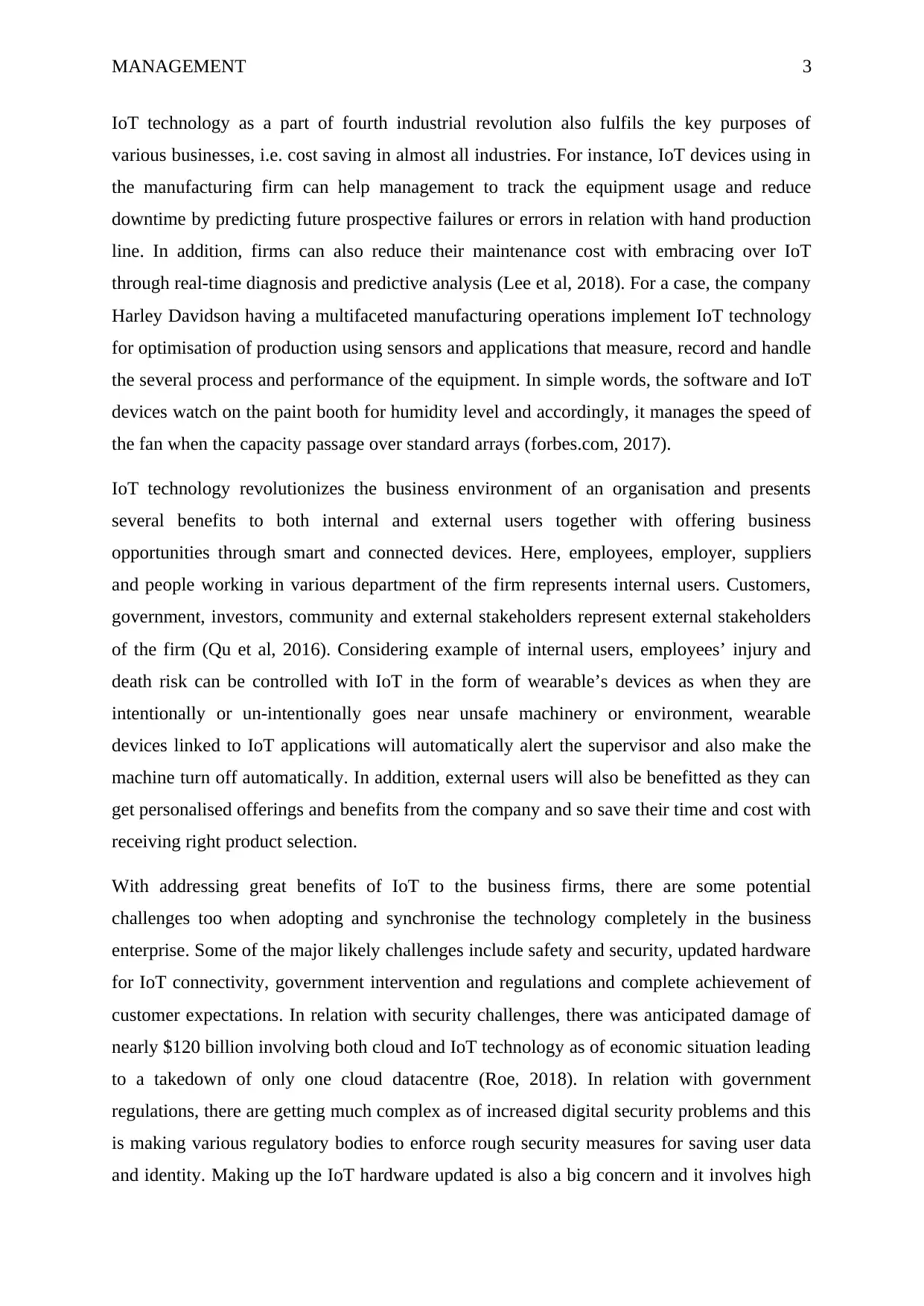
MANAGEMENT 3
IoT technology as a part of fourth industrial revolution also fulfils the key purposes of
various businesses, i.e. cost saving in almost all industries. For instance, IoT devices using in
the manufacturing firm can help management to track the equipment usage and reduce
downtime by predicting future prospective failures or errors in relation with hand production
line. In addition, firms can also reduce their maintenance cost with embracing over IoT
through real-time diagnosis and predictive analysis (Lee et al, 2018). For a case, the company
Harley Davidson having a multifaceted manufacturing operations implement IoT technology
for optimisation of production using sensors and applications that measure, record and handle
the several process and performance of the equipment. In simple words, the software and IoT
devices watch on the paint booth for humidity level and accordingly, it manages the speed of
the fan when the capacity passage over standard arrays (forbes.com, 2017).
IoT technology revolutionizes the business environment of an organisation and presents
several benefits to both internal and external users together with offering business
opportunities through smart and connected devices. Here, employees, employer, suppliers
and people working in various department of the firm represents internal users. Customers,
government, investors, community and external stakeholders represent external stakeholders
of the firm (Qu et al, 2016). Considering example of internal users, employees’ injury and
death risk can be controlled with IoT in the form of wearable’s devices as when they are
intentionally or un-intentionally goes near unsafe machinery or environment, wearable
devices linked to IoT applications will automatically alert the supervisor and also make the
machine turn off automatically. In addition, external users will also be benefitted as they can
get personalised offerings and benefits from the company and so save their time and cost with
receiving right product selection.
With addressing great benefits of IoT to the business firms, there are some potential
challenges too when adopting and synchronise the technology completely in the business
enterprise. Some of the major likely challenges include safety and security, updated hardware
for IoT connectivity, government intervention and regulations and complete achievement of
customer expectations. In relation with security challenges, there was anticipated damage of
nearly $120 billion involving both cloud and IoT technology as of economic situation leading
to a takedown of only one cloud datacentre (Roe, 2018). In relation with government
regulations, there are getting much complex as of increased digital security problems and this
is making various regulatory bodies to enforce rough security measures for saving user data
and identity. Making up the IoT hardware updated is also a big concern and it involves high
IoT technology as a part of fourth industrial revolution also fulfils the key purposes of
various businesses, i.e. cost saving in almost all industries. For instance, IoT devices using in
the manufacturing firm can help management to track the equipment usage and reduce
downtime by predicting future prospective failures or errors in relation with hand production
line. In addition, firms can also reduce their maintenance cost with embracing over IoT
through real-time diagnosis and predictive analysis (Lee et al, 2018). For a case, the company
Harley Davidson having a multifaceted manufacturing operations implement IoT technology
for optimisation of production using sensors and applications that measure, record and handle
the several process and performance of the equipment. In simple words, the software and IoT
devices watch on the paint booth for humidity level and accordingly, it manages the speed of
the fan when the capacity passage over standard arrays (forbes.com, 2017).
IoT technology revolutionizes the business environment of an organisation and presents
several benefits to both internal and external users together with offering business
opportunities through smart and connected devices. Here, employees, employer, suppliers
and people working in various department of the firm represents internal users. Customers,
government, investors, community and external stakeholders represent external stakeholders
of the firm (Qu et al, 2016). Considering example of internal users, employees’ injury and
death risk can be controlled with IoT in the form of wearable’s devices as when they are
intentionally or un-intentionally goes near unsafe machinery or environment, wearable
devices linked to IoT applications will automatically alert the supervisor and also make the
machine turn off automatically. In addition, external users will also be benefitted as they can
get personalised offerings and benefits from the company and so save their time and cost with
receiving right product selection.
With addressing great benefits of IoT to the business firms, there are some potential
challenges too when adopting and synchronise the technology completely in the business
enterprise. Some of the major likely challenges include safety and security, updated hardware
for IoT connectivity, government intervention and regulations and complete achievement of
customer expectations. In relation with security challenges, there was anticipated damage of
nearly $120 billion involving both cloud and IoT technology as of economic situation leading
to a takedown of only one cloud datacentre (Roe, 2018). In relation with government
regulations, there are getting much complex as of increased digital security problems and this
is making various regulatory bodies to enforce rough security measures for saving user data
and identity. Making up the IoT hardware updated is also a big concern and it involves high
Paraphrase This Document
Need a fresh take? Get an instant paraphrase of this document with our AI Paraphraser
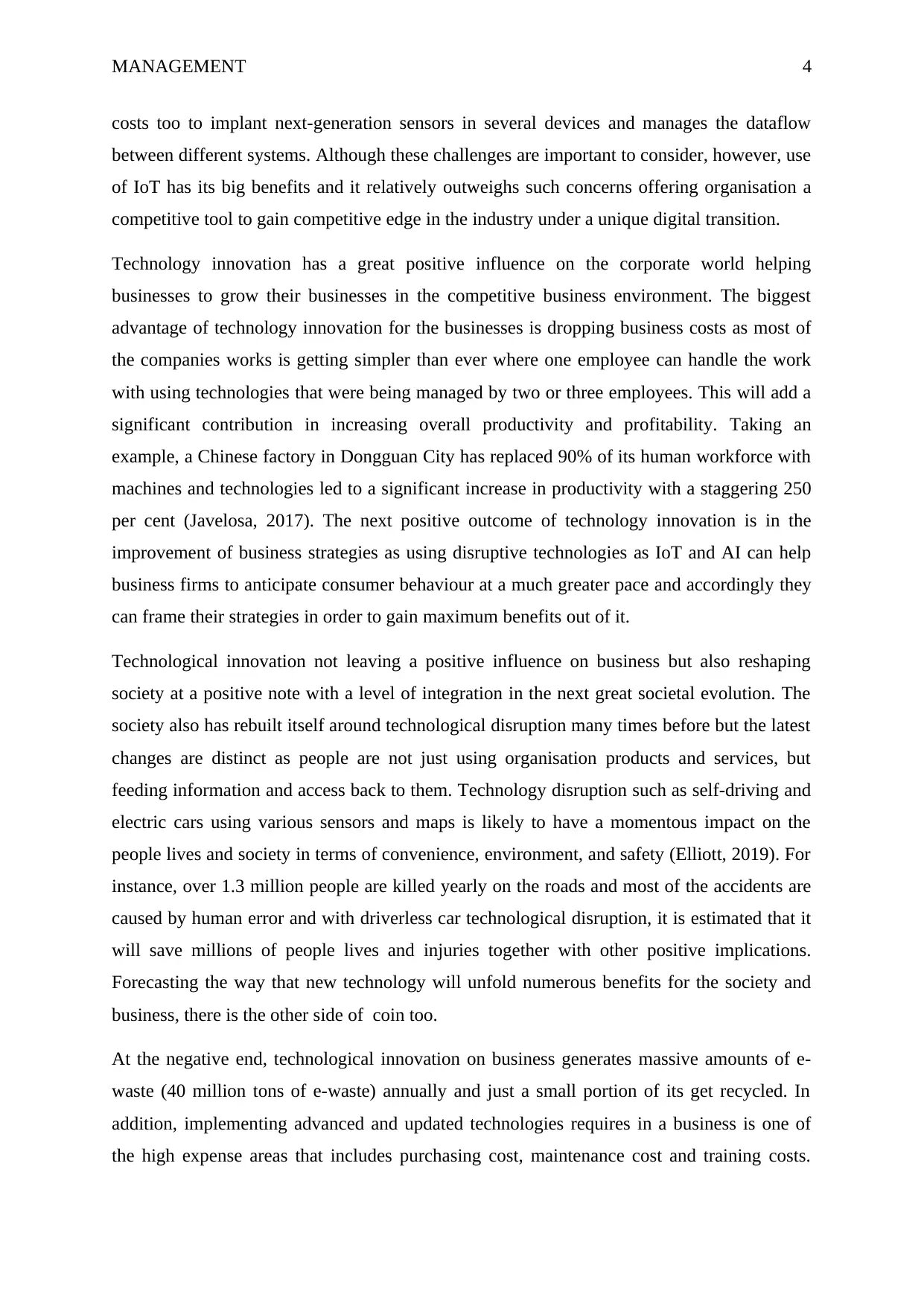
MANAGEMENT 4
costs too to implant next-generation sensors in several devices and manages the dataflow
between different systems. Although these challenges are important to consider, however, use
of IoT has its big benefits and it relatively outweighs such concerns offering organisation a
competitive tool to gain competitive edge in the industry under a unique digital transition.
Technology innovation has a great positive influence on the corporate world helping
businesses to grow their businesses in the competitive business environment. The biggest
advantage of technology innovation for the businesses is dropping business costs as most of
the companies works is getting simpler than ever where one employee can handle the work
with using technologies that were being managed by two or three employees. This will add a
significant contribution in increasing overall productivity and profitability. Taking an
example, a Chinese factory in Dongguan City has replaced 90% of its human workforce with
machines and technologies led to a significant increase in productivity with a staggering 250
per cent (Javelosa, 2017). The next positive outcome of technology innovation is in the
improvement of business strategies as using disruptive technologies as IoT and AI can help
business firms to anticipate consumer behaviour at a much greater pace and accordingly they
can frame their strategies in order to gain maximum benefits out of it.
Technological innovation not leaving a positive influence on business but also reshaping
society at a positive note with a level of integration in the next great societal evolution. The
society also has rebuilt itself around technological disruption many times before but the latest
changes are distinct as people are not just using organisation products and services, but
feeding information and access back to them. Technology disruption such as self-driving and
electric cars using various sensors and maps is likely to have a momentous impact on the
people lives and society in terms of convenience, environment, and safety (Elliott, 2019). For
instance, over 1.3 million people are killed yearly on the roads and most of the accidents are
caused by human error and with driverless car technological disruption, it is estimated that it
will save millions of people lives and injuries together with other positive implications.
Forecasting the way that new technology will unfold numerous benefits for the society and
business, there is the other side of coin too.
At the negative end, technological innovation on business generates massive amounts of e-
waste (40 million tons of e-waste) annually and just a small portion of its get recycled. In
addition, implementing advanced and updated technologies requires in a business is one of
the high expense areas that includes purchasing cost, maintenance cost and training costs.
costs too to implant next-generation sensors in several devices and manages the dataflow
between different systems. Although these challenges are important to consider, however, use
of IoT has its big benefits and it relatively outweighs such concerns offering organisation a
competitive tool to gain competitive edge in the industry under a unique digital transition.
Technology innovation has a great positive influence on the corporate world helping
businesses to grow their businesses in the competitive business environment. The biggest
advantage of technology innovation for the businesses is dropping business costs as most of
the companies works is getting simpler than ever where one employee can handle the work
with using technologies that were being managed by two or three employees. This will add a
significant contribution in increasing overall productivity and profitability. Taking an
example, a Chinese factory in Dongguan City has replaced 90% of its human workforce with
machines and technologies led to a significant increase in productivity with a staggering 250
per cent (Javelosa, 2017). The next positive outcome of technology innovation is in the
improvement of business strategies as using disruptive technologies as IoT and AI can help
business firms to anticipate consumer behaviour at a much greater pace and accordingly they
can frame their strategies in order to gain maximum benefits out of it.
Technological innovation not leaving a positive influence on business but also reshaping
society at a positive note with a level of integration in the next great societal evolution. The
society also has rebuilt itself around technological disruption many times before but the latest
changes are distinct as people are not just using organisation products and services, but
feeding information and access back to them. Technology disruption such as self-driving and
electric cars using various sensors and maps is likely to have a momentous impact on the
people lives and society in terms of convenience, environment, and safety (Elliott, 2019). For
instance, over 1.3 million people are killed yearly on the roads and most of the accidents are
caused by human error and with driverless car technological disruption, it is estimated that it
will save millions of people lives and injuries together with other positive implications.
Forecasting the way that new technology will unfold numerous benefits for the society and
business, there is the other side of coin too.
At the negative end, technological innovation on business generates massive amounts of e-
waste (40 million tons of e-waste) annually and just a small portion of its get recycled. In
addition, implementing advanced and updated technologies requires in a business is one of
the high expense areas that includes purchasing cost, maintenance cost and training costs.
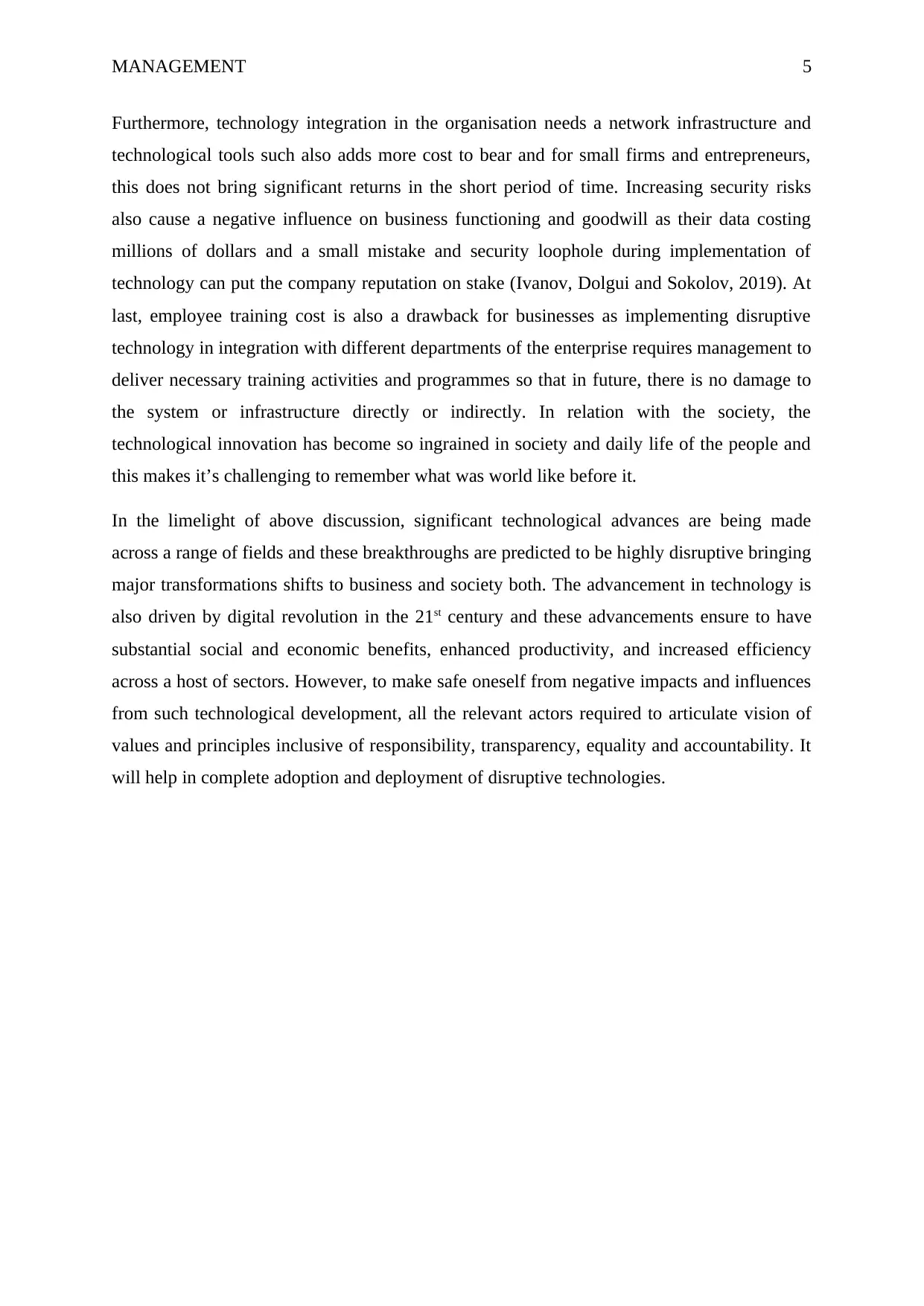
MANAGEMENT 5
Furthermore, technology integration in the organisation needs a network infrastructure and
technological tools such also adds more cost to bear and for small firms and entrepreneurs,
this does not bring significant returns in the short period of time. Increasing security risks
also cause a negative influence on business functioning and goodwill as their data costing
millions of dollars and a small mistake and security loophole during implementation of
technology can put the company reputation on stake (Ivanov, Dolgui and Sokolov, 2019). At
last, employee training cost is also a drawback for businesses as implementing disruptive
technology in integration with different departments of the enterprise requires management to
deliver necessary training activities and programmes so that in future, there is no damage to
the system or infrastructure directly or indirectly. In relation with the society, the
technological innovation has become so ingrained in society and daily life of the people and
this makes it’s challenging to remember what was world like before it.
In the limelight of above discussion, significant technological advances are being made
across a range of fields and these breakthroughs are predicted to be highly disruptive bringing
major transformations shifts to business and society both. The advancement in technology is
also driven by digital revolution in the 21st century and these advancements ensure to have
substantial social and economic benefits, enhanced productivity, and increased efficiency
across a host of sectors. However, to make safe oneself from negative impacts and influences
from such technological development, all the relevant actors required to articulate vision of
values and principles inclusive of responsibility, transparency, equality and accountability. It
will help in complete adoption and deployment of disruptive technologies.
Furthermore, technology integration in the organisation needs a network infrastructure and
technological tools such also adds more cost to bear and for small firms and entrepreneurs,
this does not bring significant returns in the short period of time. Increasing security risks
also cause a negative influence on business functioning and goodwill as their data costing
millions of dollars and a small mistake and security loophole during implementation of
technology can put the company reputation on stake (Ivanov, Dolgui and Sokolov, 2019). At
last, employee training cost is also a drawback for businesses as implementing disruptive
technology in integration with different departments of the enterprise requires management to
deliver necessary training activities and programmes so that in future, there is no damage to
the system or infrastructure directly or indirectly. In relation with the society, the
technological innovation has become so ingrained in society and daily life of the people and
this makes it’s challenging to remember what was world like before it.
In the limelight of above discussion, significant technological advances are being made
across a range of fields and these breakthroughs are predicted to be highly disruptive bringing
major transformations shifts to business and society both. The advancement in technology is
also driven by digital revolution in the 21st century and these advancements ensure to have
substantial social and economic benefits, enhanced productivity, and increased efficiency
across a host of sectors. However, to make safe oneself from negative impacts and influences
from such technological development, all the relevant actors required to articulate vision of
values and principles inclusive of responsibility, transparency, equality and accountability. It
will help in complete adoption and deployment of disruptive technologies.
⊘ This is a preview!⊘
Do you want full access?
Subscribe today to unlock all pages.

Trusted by 1+ million students worldwide
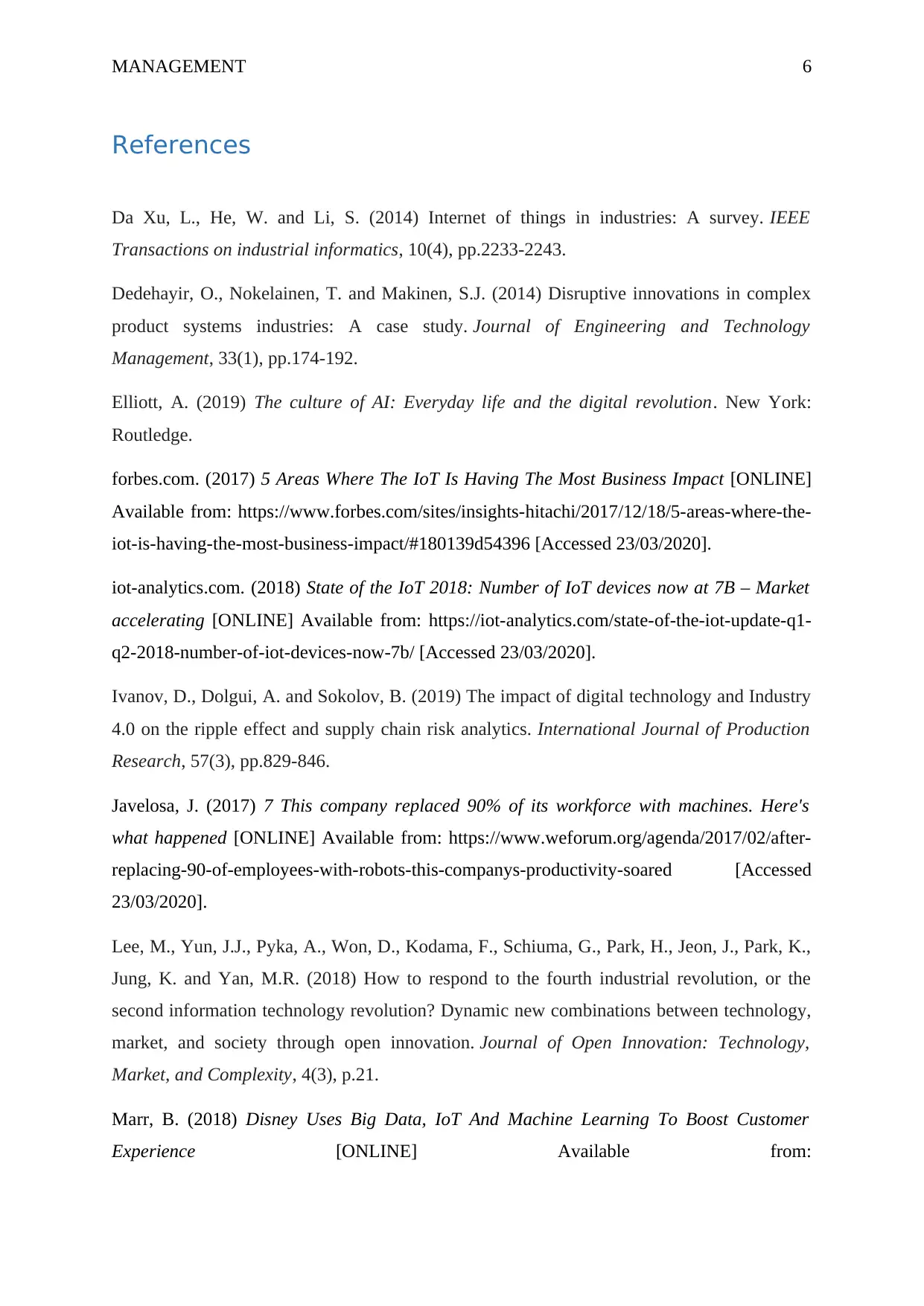
MANAGEMENT 6
References
Da Xu, L., He, W. and Li, S. (2014) Internet of things in industries: A survey. IEEE
Transactions on industrial informatics, 10(4), pp.2233-2243.
Dedehayir, O., Nokelainen, T. and Makinen, S.J. (2014) Disruptive innovations in complex
product systems industries: A case study. Journal of Engineering and Technology
Management, 33(1), pp.174-192.
Elliott, A. (2019) The culture of AI: Everyday life and the digital revolution. New York:
Routledge.
forbes.com. (2017) 5 Areas Where The IoT Is Having The Most Business Impact [ONLINE]
Available from: https://www.forbes.com/sites/insights-hitachi/2017/12/18/5-areas-where-the-
iot-is-having-the-most-business-impact/#180139d54396 [Accessed 23/03/2020].
iot-analytics.com. (2018) State of the IoT 2018: Number of IoT devices now at 7B – Market
accelerating [ONLINE] Available from: https://iot-analytics.com/state-of-the-iot-update-q1-
q2-2018-number-of-iot-devices-now-7b/ [Accessed 23/03/2020].
Ivanov, D., Dolgui, A. and Sokolov, B. (2019) The impact of digital technology and Industry
4.0 on the ripple effect and supply chain risk analytics. International Journal of Production
Research, 57(3), pp.829-846.
Javelosa, J. (2017) 7 This company replaced 90% of its workforce with machines. Here's
what happened [ONLINE] Available from: https://www.weforum.org/agenda/2017/02/after-
replacing-90-of-employees-with-robots-this-companys-productivity-soared [Accessed
23/03/2020].
Lee, M., Yun, J.J., Pyka, A., Won, D., Kodama, F., Schiuma, G., Park, H., Jeon, J., Park, K.,
Jung, K. and Yan, M.R. (2018) How to respond to the fourth industrial revolution, or the
second information technology revolution? Dynamic new combinations between technology,
market, and society through open innovation. Journal of Open Innovation: Technology,
Market, and Complexity, 4(3), p.21.
Marr, B. (2018) Disney Uses Big Data, IoT And Machine Learning To Boost Customer
Experience [ONLINE] Available from:
References
Da Xu, L., He, W. and Li, S. (2014) Internet of things in industries: A survey. IEEE
Transactions on industrial informatics, 10(4), pp.2233-2243.
Dedehayir, O., Nokelainen, T. and Makinen, S.J. (2014) Disruptive innovations in complex
product systems industries: A case study. Journal of Engineering and Technology
Management, 33(1), pp.174-192.
Elliott, A. (2019) The culture of AI: Everyday life and the digital revolution. New York:
Routledge.
forbes.com. (2017) 5 Areas Where The IoT Is Having The Most Business Impact [ONLINE]
Available from: https://www.forbes.com/sites/insights-hitachi/2017/12/18/5-areas-where-the-
iot-is-having-the-most-business-impact/#180139d54396 [Accessed 23/03/2020].
iot-analytics.com. (2018) State of the IoT 2018: Number of IoT devices now at 7B – Market
accelerating [ONLINE] Available from: https://iot-analytics.com/state-of-the-iot-update-q1-
q2-2018-number-of-iot-devices-now-7b/ [Accessed 23/03/2020].
Ivanov, D., Dolgui, A. and Sokolov, B. (2019) The impact of digital technology and Industry
4.0 on the ripple effect and supply chain risk analytics. International Journal of Production
Research, 57(3), pp.829-846.
Javelosa, J. (2017) 7 This company replaced 90% of its workforce with machines. Here's
what happened [ONLINE] Available from: https://www.weforum.org/agenda/2017/02/after-
replacing-90-of-employees-with-robots-this-companys-productivity-soared [Accessed
23/03/2020].
Lee, M., Yun, J.J., Pyka, A., Won, D., Kodama, F., Schiuma, G., Park, H., Jeon, J., Park, K.,
Jung, K. and Yan, M.R. (2018) How to respond to the fourth industrial revolution, or the
second information technology revolution? Dynamic new combinations between technology,
market, and society through open innovation. Journal of Open Innovation: Technology,
Market, and Complexity, 4(3), p.21.
Marr, B. (2018) Disney Uses Big Data, IoT And Machine Learning To Boost Customer
Experience [ONLINE] Available from:
Paraphrase This Document
Need a fresh take? Get an instant paraphrase of this document with our AI Paraphraser
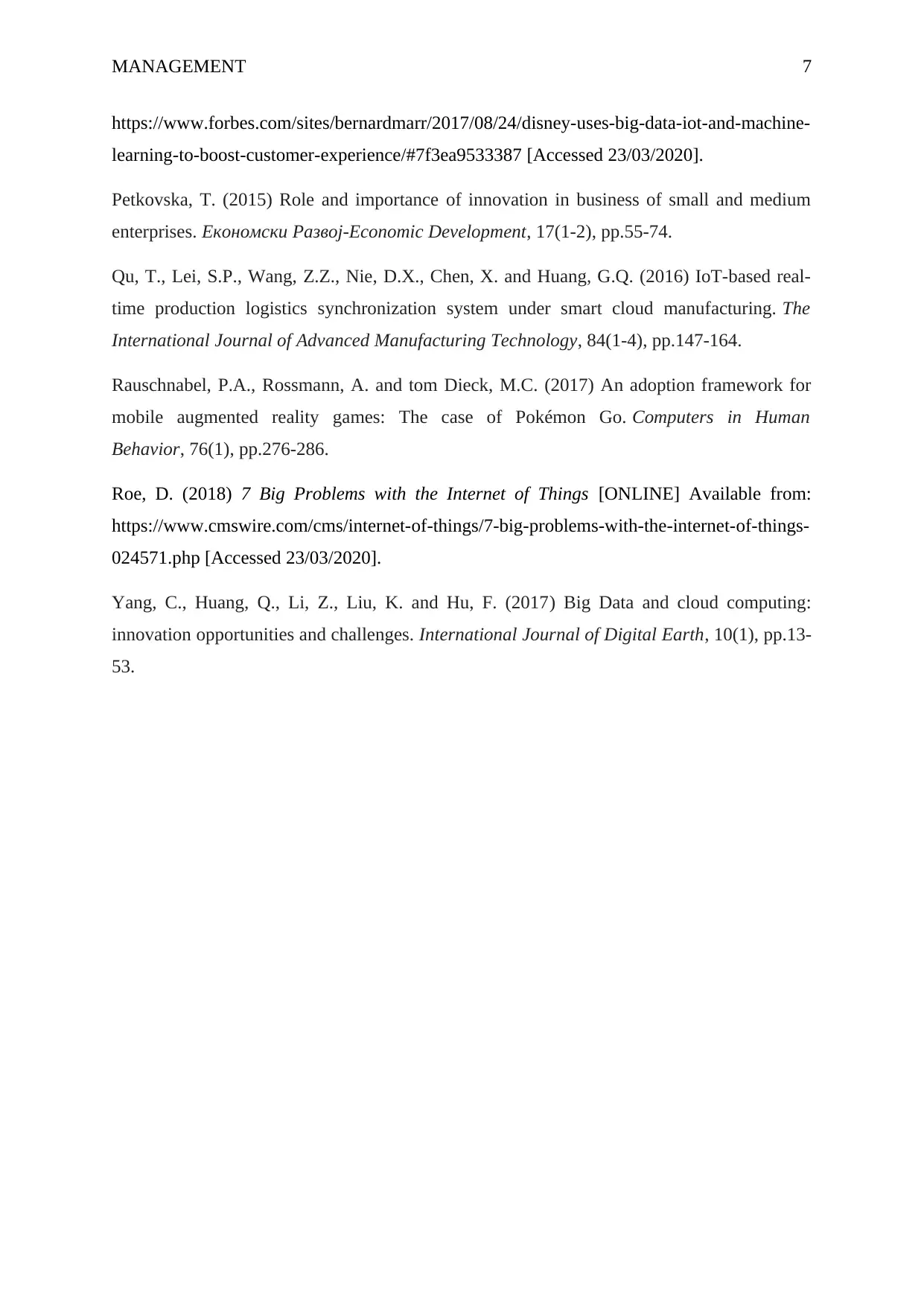
MANAGEMENT 7
https://www.forbes.com/sites/bernardmarr/2017/08/24/disney-uses-big-data-iot-and-machine-
learning-to-boost-customer-experience/#7f3ea9533387 [Accessed 23/03/2020].
Petkovska, T. (2015) Role and importance of innovation in business of small and medium
enterprises. Економски Развој-Economic Development, 17(1-2), pp.55-74.
Qu, T., Lei, S.P., Wang, Z.Z., Nie, D.X., Chen, X. and Huang, G.Q. (2016) IoT-based real-
time production logistics synchronization system under smart cloud manufacturing. The
International Journal of Advanced Manufacturing Technology, 84(1-4), pp.147-164.
Rauschnabel, P.A., Rossmann, A. and tom Dieck, M.C. (2017) An adoption framework for
mobile augmented reality games: The case of Pokémon Go. Computers in Human
Behavior, 76(1), pp.276-286.
Roe, D. (2018) 7 Big Problems with the Internet of Things [ONLINE] Available from:
https://www.cmswire.com/cms/internet-of-things/7-big-problems-with-the-internet-of-things-
024571.php [Accessed 23/03/2020].
Yang, C., Huang, Q., Li, Z., Liu, K. and Hu, F. (2017) Big Data and cloud computing:
innovation opportunities and challenges. International Journal of Digital Earth, 10(1), pp.13-
53.
https://www.forbes.com/sites/bernardmarr/2017/08/24/disney-uses-big-data-iot-and-machine-
learning-to-boost-customer-experience/#7f3ea9533387 [Accessed 23/03/2020].
Petkovska, T. (2015) Role and importance of innovation in business of small and medium
enterprises. Економски Развој-Economic Development, 17(1-2), pp.55-74.
Qu, T., Lei, S.P., Wang, Z.Z., Nie, D.X., Chen, X. and Huang, G.Q. (2016) IoT-based real-
time production logistics synchronization system under smart cloud manufacturing. The
International Journal of Advanced Manufacturing Technology, 84(1-4), pp.147-164.
Rauschnabel, P.A., Rossmann, A. and tom Dieck, M.C. (2017) An adoption framework for
mobile augmented reality games: The case of Pokémon Go. Computers in Human
Behavior, 76(1), pp.276-286.
Roe, D. (2018) 7 Big Problems with the Internet of Things [ONLINE] Available from:
https://www.cmswire.com/cms/internet-of-things/7-big-problems-with-the-internet-of-things-
024571.php [Accessed 23/03/2020].
Yang, C., Huang, Q., Li, Z., Liu, K. and Hu, F. (2017) Big Data and cloud computing:
innovation opportunities and challenges. International Journal of Digital Earth, 10(1), pp.13-
53.
1 out of 8
Related Documents
Your All-in-One AI-Powered Toolkit for Academic Success.
+13062052269
info@desklib.com
Available 24*7 on WhatsApp / Email
![[object Object]](/_next/static/media/star-bottom.7253800d.svg)
Unlock your academic potential
Copyright © 2020–2025 A2Z Services. All Rights Reserved. Developed and managed by ZUCOL.





